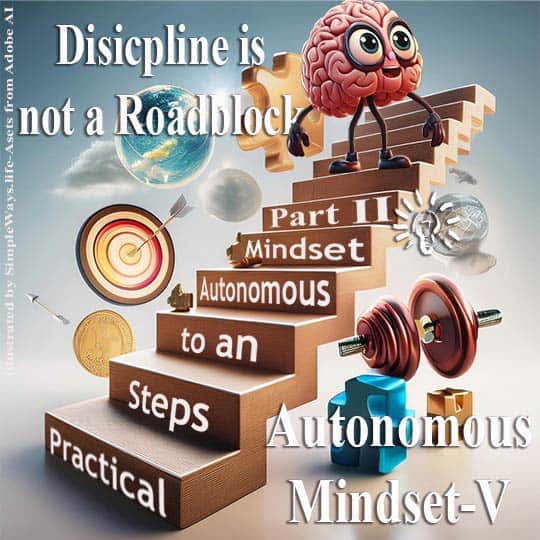As we delve deeper into developing an autonomous mindset to thrive, let’s explore how theory transforms into practice through vivid, real-world examples. By engaging your imagination and visualizing yourself embodying these principles, you’ll find them naturally manifesting in your daily life. For a comprehensive framework of adaptable mindsets and practical implementations, you can reference: Mindset Manifesto, Blueprint for Life, Tech & Success
Ready to transform your mindset? Click and Get your copy > Now For Sale on Simpleways.life & Amazon
Autonomous mindset embodies a state of self-reliance, independence, and the capacity to make decisions and take actions without needing constant external input or direction. Let’s continue breaking down what it takes to develop this mindset
In our previous discussion on practical steps toward autonomous mindset, –Practical steps to an Autonomous Mindset– we examined three fundamental elements: self-awareness, goal clarity, and motivation. While motivation is often considered the primary driver of autonomous thinking, it’s just one piece of the puzzle. Consider a highly motivated professional who lacks self-awareness – they might miss crucial opportunities simply because they’re not attuned to the underlying patterns in their life and work. Similarly, a motivated team without clear objectives might expend tremendous energy yet fail to achieve meaningful results.
The key to sustaining motivation lies in creating an environment where it can flourish. Think of motivation like a garden – it’s not enough to plant the seeds; you must also remove the weeds (motivation inhibitors) and create optimal conditions for growth. This means actively identifying and eliminating factors that drain your motivation while cultivating those that enhance it.

CUSTOMPRICE-TO2JAN26
A couple more foundations for Autonomous Mindset to thrive
As we move forward, we’ll focus on two critical components that cement these practices into lasting habits: discipline and resilience. These elements serve as the foundation that enables all other aspects of autonomous mindset to take root and thrive. Remember, transforming your mindset isn’t about dramatic overnight changes. Instead, it’s about consistent, intentional practice – starting with one or two elements and gradually expanding your capabilities. Then we shall continue with more supporting tactics.
The beauty of this approach lies in its compound effect: even modest, consistent efforts can dramatically reshape your motivation, autonomy, and overall well-being over time. By building this foundation of discipline and resilience, you’ll be better equipped to explore and integrate the other essential building blocks of autonomous mindset that we’ll discuss in our journey ahead.

CUSTOMPRICE-TO2JAN26
Strengthen Discipline
While motivation ignites our initial drive toward goals, discipline acts as the sturdy framework that keeps us moving forward when motivation naturally fluctuates. Think of motivation as the spark that gets you excited about a morning workout, while discipline is what gets you out of bed at 5 AM even when that excitement wanes. By developing strong disciplinary habits – whether it’s sticking to a daily schedule, maintaining consistent work routines, or following through on commitments – we create a reliable system that sustains our progress regardless of our emotional state.
Then, as we see the results of our disciplined efforts, we experience small wins that reignite our motivational fire. That’s exactly what we mean by thriving on autonomous mindset. Over time, this interplay between discipline and motivation creates a powerful upward spiral where each element strengthens the other, making our autonomous journey more sustainable and enjoyable. The key lies in recognizing that discipline isn’t the opposite of freedom or creativity, but rather its most loyal ally in the pursuit of lasting change.
Time-Blocking:
Allocate specific times for focused work, breaks, and leisure. Use a timer to stay on track.
Example: A freelance writer, blocks 9 a.m.–11 a.m. for drafting articles. He silences his phone and uses the Pomodoro technique (25 minutes of work, 5-minute breaks) to maintain focus.
Another Example: A fitness coach who runs her own online business blocks 2 p.m.–4 p.m. for client program development. She sets her office status to “focused work,” closes all browser tabs except her planning software, and follows a structured 50/10 rhythm (50 minutes of concentrated work followed by a 10-minute movement break). During each focused block, she creates one complete client workout plan, keeping a visible progress tracker on her desk. This consistent scheduling not only ensures she meets her business commitments but also models the same discipline she encourages in her clients.

CUSTOMPRICE-TO2JAN26
Habit Stacking:
Link new habits to existing ones. For instance, after brushing your teeth, review your daily to-do list. This will help you Reduce the mental friction of starting new habits by attaching them to existing behavioral triggers. And, maximizes usage of otherwise “dead” time in our daily routines by building upon our brain’s natural tendency to create sequences of behavior. This way it is easier to maintain consistency since we’re less likely to forget or skip the new habit
Practical Example: A software developer anchors his the review of new approaches in code practice to his daily commute. During his 20-minute train ride home, he dedicates that time to reviewing one coding tutorial or reading a technical article. He pairs this with his existing habit of putting on headphones for the journey, creating a natural transition into focused learning time. Over time, this consistent practice has built his expertise and kept him updated with industry trends, all by leveraging a daily routine he already had in place.
Another Example: A team lead links her coffee routine to planning her day. While sipping her morning coffee, she writes down her top 3 priorities.

CUSTOMPRICE-TO2JAN26

CUSTOMPRICE-TO2JAN26
Practice Delayed Gratification:
Challenge yourself to be aware of and control distractions. This practice builds patience, focus, and mental fortitude – key components of discipline. By consciously choosing to postpone immediate pleasures for longer-term benefits, we strengthen our self-control muscles and enhance our ability to maintain focus on important tasks.
Practical Example 1: Our friend for this example resists opening social media until he finishes reading one chapter of his textbook. This simple discipline strengthens his ability to concentrate. Over time, he finds himself naturally extending his focus periods and experiencing deeper learning.
Another Practical Example 2: A graphic designer implements a “rewards system” for client projects. She resists checking incoming emails until she completes one full design mockup. Only after finishing each significant milestone does she allow herself a 15-minute break to catch up on communications. As a result, her work quality has improved due to fewer interruptions, and she’s discovered that the anticipation of the break actually makes her more productive during focused work time.
The power of delayed gratification lies in its compound effect – each small victory in resisting immediate pleasure builds stronger neural pathways for self-control, making future acts of discipline progressively easier. It’s like building a muscle – the more you exercise it, the stronger it becomes.

CUSTOMPRICE-TO2JAN26
In Conclusion,
The journey to discipline isn’t about rigid control but rather about building sustainable practices that support our autonomous growth. Through time-blocking, habit stacking, and practicing delayed gratification, we create a framework that keeps us moving forward even when motivation naturally ebbs. These disciplined practices work in harmony with our self-awareness – helping us recognize patterns in our behavior and identify opportunities for growth – while providing the consistent structure that motivation needs to thrive.
Think of discipline as the bridge between awareness and action. When we’re aware of our patterns and motivated to change them, discipline provides the daily practices that turn these insights into lasting transformation. Whether it’s a freelance writer protecting their creative hours, a team lead linking planning to their morning coffee, or a student mastering the art of focused study before social media breaks, each disciplined choice strengthens our autonomous mindset.
As we move forward to explore resilience and ecosystem tools, remember that discipline sets the stage for these next elements. The resilience to bounce back from setbacks and the ability to leverage our environment effectively both build upon the foundation of disciplined practice. Just as a well-tended garden needs both strong roots (discipline) and the right environment (ecosystem) to thrive, our autonomous mindset grows stronger when all these elements work together.
By practicing these exercises and referring to the examples, you can develop an autonomous mindset more efficiently and effectively.
If you feel you need help with any of these ideas we discussed, request a Management Consultancy or Coaching Services From our Store











